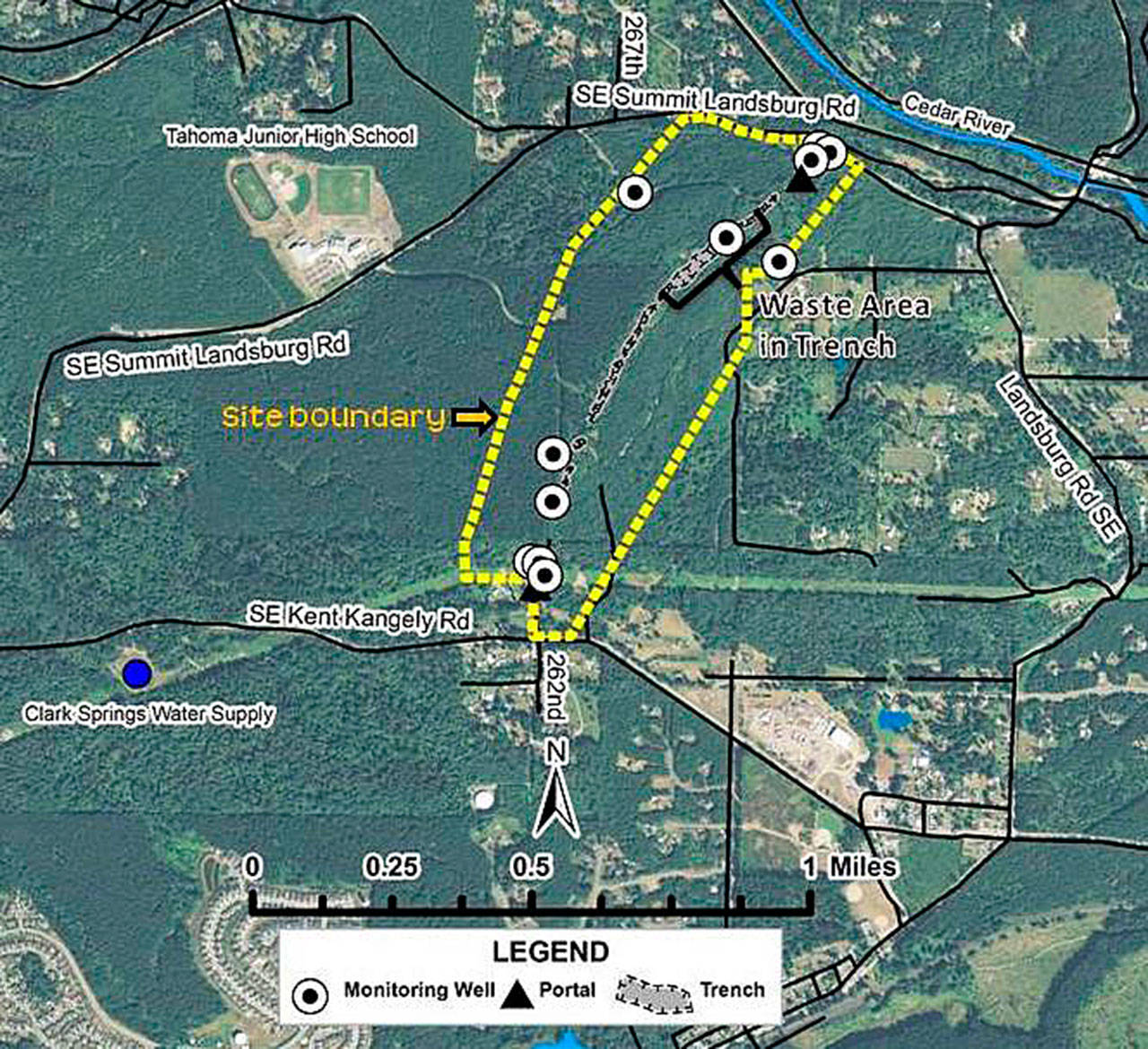The longtime clash between the city of Kent and the state Department of Ecology over the cleanup of the Landsburg Mine industrial waste site continues to simmer.
City leaders have kept a close watch about the state’s plan for more than two decades because the waste site sits just east of Kent in Ravensdale near the Clark Springs watershed – the city’s primary drinking water supply.
Ecology initiated its cleanup plan earlier this year after implementation of the consent decree, a settlement between the state and the companies responsible for the waste who will pay for the project. State officials and representatives of the companies estimate the cost at $3.9 million, although that figure was released in 2014 and has not been updated.
City staff provided information July 2 about the Landsburg Mine to the City Council’s Public Works Committee.
“It was quite clear we still have safe, pristine water here in Kent,” City Councilwoman Brenda Fincher said about the report during the July 3 council meeting. “We are hoping for increased monitoring to happen because there is some seeping from the mine, but nothing into our water. We want to check to make sure the Ecology Department is doing all they can to keep our water safe for residents in Kent.”
City officials are crafting a letter to send to Ecology for increased monitoring, planned responses to potential contamination and getting information to the city quicker in an effort to keep track of state actions.
The trench, above an old underground coal mine, stretches about three-fourths of a mile long and goes 20 to 60 feet deep just north of the Clark Springs watershed.
Mike Mactutis, city environmental engineering manager, told the council committee that the mine (which closed in 1975) has two portals and the city is concerned about the south side portal. Companies dumped more than 500,000 gallons of waste – half in barrels and half dumped right out of trucks – from 1969 to 1978.
“Some material is dense, some is dissolvable and some lighter than water so it floats,” Mactutis said.
The barrels contain paint waste, solvents, heavy metals, oily water and sludge, according to state documents.
The responsible companies include Browning-Ferris Industries of Illinois, Inc.; BNSF Railway; PACCAR, Inc.; Plum Creek Timberlands, L.P.; TOC Holdings Co.; and Palmer Coking Coal Co., which owns the property where the waste was dumped.
Tim LaPorte, city Public Works director, said it’s hard to know where the waste is buried.
“They dumped for 10 years,” LaPorte said. “Some would just unlock the gate and go dump it. It’s a best guess what is dumped where.”
The state Department of Health also studied the Landsburg Mine site (at the request of city officials) and determined the buried wastes could pose a potential threat.
That’s why city leaders want Ecology to do more testing with monitoring wells.
“I don’t have specific pinned-down dates, but two more wells for groundwater sampling are scheduled for installation this year,” said Ecology spokesman Larry Altose in an email. “This would involve a well-drilling rig.”
Mactutis said the city has concerns about Ecology’s opinion that groundwater farther south of main dumping zone flows to the north, away from the Clark Springs Watershed.
“The location of wells is far apart so it’s hard to tell,” Mactutis said.
The city recently bought the nearby Gribble property to add another city monitoring well to try to determine if chemicals are coming out of the south portal.
“So far all tests have been clean, so have DOE (Ecology) tests from its wells,” Mactutis said.
Altose said the additional monitoring wells going in will help determine if a water treatment system needs to be installed.
A Engineering Design Report (EDR) for the project is expected to be approved by the state later this year. That will kick off the construction phase at the trench.
“This phase includes filling in part of the trench where wastes are located, and covering it with a protective cap,” according to Ecology’s Landsburg Mine website. “The filling of the trench will occur over two years to allow the fill to settle. Ecology will closely monitor the site during this process.”
That work is expected to help make sure drinking water stays safe. Construction could start next year.
“We believe that installing the cap will provide significant protection to the environment and public health by isolating the wastes from exposure to direct contact with people and animals, plus greatly reducing the flow of stormwater into the disposal area,” Altose said. “This will limit the primary factor that could cause movement of any contaminants into the groundwater.”
Councilman Dennis Higgins asked city staff what would happen if the Clark Springs Water supply became contaminated.
LaPorte said the city’s secondary water source from the city of Tacoma and the Green River watershed would become the only water source.
“We would switch to 100 percent Tacoma water, and we would isolate the Clark Springs source,” LaPorte said. “We would survive OK, but we don’t want to rely on one (source) for our water supply.”
Talk to us
Please share your story tips by emailing editor@kentreporter.com.
To share your opinion for publication, submit a letter through our website https://www.kentreporter.com/submit-letter/. Include your name, address and daytime phone number. (We’ll only publish your name and hometown.) Please keep letters to 300 words or less.

